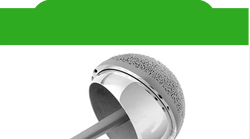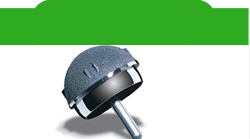Details of the procedure
The hip resurfacing is performed in an operating room with a special laminar airflow system, which helps reduce the chance of infection. Your surgeon will be wearing a “spacesuit”, also designed to reduce the chance of infection. The entire surgical team will consist of your surgeon, two to three assistants, and a scrub nurse.
The anesthesia for a hip resurfacing is given through an epidural catheter, which is a small tube inserted into the back. This is the same type of anesthesia given to women in labor. You will be made numb from the waist down so that you will not feel anything. The catheter stays in for 1-2 days after the surgery to help with your post-operative pain control. During the course of the operation, you can be as awake or as sleepy as you want to be.
After the epidural block is administered, you will be placed on your side. The incision for a total hip replacement is made along the side of your hip. The incision will measure anywhere from 6 to 10 inches depending upon your anatomy. It is well-covered by undergarments and is usually not visible when wearing clothes.
The arthritic ball and socket are exposed and sculpted to accept the resurfacing implant. The socket is placed into the body without cement; over time your bone will grow onto the socket. The resurfacing ball is inserted with cement. During the closure, two drains are inserted around the operated area to assist with evacuation of blood. Staples and sutures are used to close the skin.
The entire operation will take from 1.5 to 2 hours. Afterwards, you will be brought to the recovery room, where your blood work will be checked, and an x-ray of your new hip will be taken. Most patients can be brought to a regular room within a few hours; others will need to stay overnight in the recovery room, as determined by your surgeon and anesthesiologist. Patients generally stay in the hospital for 2-3 days following hip resurfacing surgery.
Pre-operative orientation
Most patients will be asked to donate 1 pint of their own blood in the weeks preceding hip resurfacing. This helps reduce the need for a blood transfusion from our blood bank. Almost all of the patients will receive the donated blood as a transfusion after surgery. Rarely, an additional transfusion is necessary from our blood bank. The blood from the blood bank is carefully screened to the best of our ability to detect any infectious diseases.
You will be asked to see a medical doctor at HSS prior to your surgery. This is a precaution to make certain that you are healthy enough to undergo hip replacement surgery. In the course of this workup, you may be asked to have additional testing to examine your heart and lung function. After your surgery, this medical doctor will see you in the hospital.
Post-operative course
Immediately after hip resurfacing surgery, you will be in the recovery room. Most patients are able to go to a regular room after a few hours, when the sensation returns in your legs. You will be given a pain pump connected to your epidural catheter which will allow you to control when you are given pain medicine. Most people are quite comfortable with the pain pump in place.
On the day of surgery, you may do some of the exercises as instructed by your physical therapist, including buttock clenches and moving the feet up and down. You will be allowed to take some ice chips after surgery to wet your mouth, but drinking liquids or eating may cause you to become nauseated. You will have a catheter in your bladder so that you do not have to worry about urinating. Following the surgery, this is mainly a day of rest.
The first day after surgery will have a lot of activity. You will meet our physiotherapists, who will instruct you in more exercises to perform while in bed. In addition, they will help you stand today and take a few steps with a walker. Generally, you will be allowed to drink clear liquids in the morning and regular food by the evening.
The next day you will find it easier and easier to move about. You will be freed up from the pain and urinary catheters. Pain medication will be given in the form of tablets. Eventually you will progress to walking with 2 crutches, either under the armpit or forearm crutches.
You will be discharged home when you have demonstrated that you can get in and out of bed and walk safely. A physiotherapist will come to your house to continue rehabilitation. A case manager will discuss these options with you and help you plan for your eventual return home.
Your return to activity will be guided by your surgeon and therapists. After 3 weeks, you may transition to a single cane or crutch. Generally, patients are able to walk as much as they want by 6 weeks post-operatively. Patients are able to resume driving an automatic transmission at 3-4 weeks, as long as reaction times are normal and he/she is not requiring pain medication. At 8 weeks, patients are able to resume playing golf and swimming; at 12 weeks, they may play tennis. Your surgeon will help you decide what activities you may resume.
The Center for Hip Pain & Preservation
541 East 71st Street
New York, NY 10021
 Click here for Driving Directions
Click here for Driving Directions

















